Analyzing Puchong's Development through Urban Planning Theories
VerifiedAdded on 2021/04/19
|9
|2924
|454
Report
AI Summary
This report analyzes the development of Puchong, Malaysia, through the application of various urban theories. It begins with a brief history of Puchong, highlighting its transformation from a rural settlement to an urban center, and explores how theories like the Central Place Theory and Rank Size Rule explain its early development and the influence of its proximity to Kuala Lumpur. The report then examines Puchong's future concerns, considering the implications of location theory, urban agglomeration, and the importance of widening its economic base through diversification in industries like banking and tourism, as well as infrastructure investment. It also discusses the built environment, emphasizing the need for sustainable urban planning to manage sprawl, address issues like traffic congestion and climate change, and promote decentralization. The report concludes by emphasizing the importance of continued investment in infrastructure, economic diversification, and quality of life to ensure Puchong's sustained growth and development.
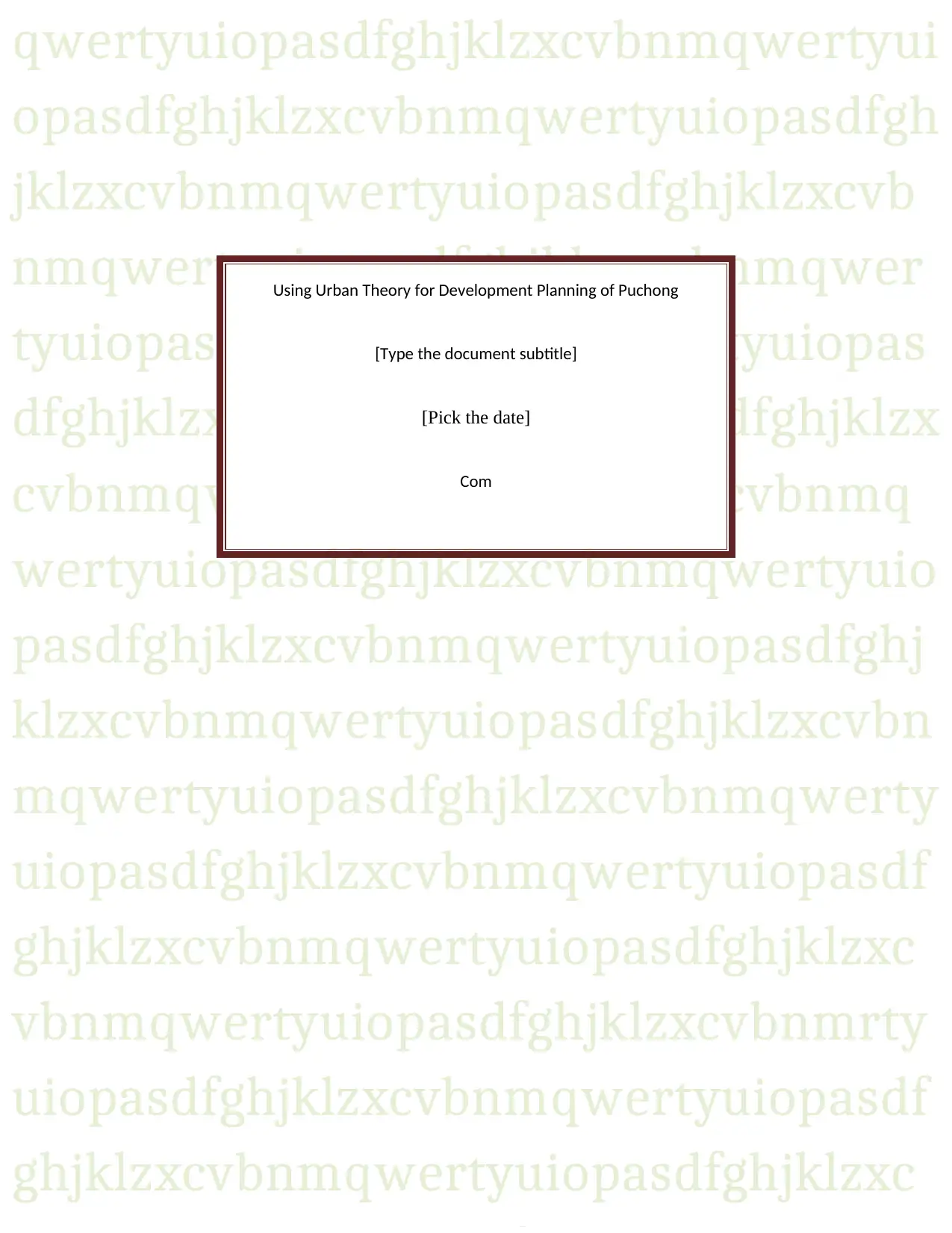
qwertyuiopasdfghjklzxcvbnmqwertyui
opasdfghjklzxcvbnmqwertyuiopasdfgh
jklzxcvbnmqwertyuiopasdfghjklzxcvb
nmqwertyuiopasdfghjklzxcvbnmqwer
tyuiopasdfghjklzxcvbnmqwertyuiopas
dfghjklzxcvbnmqwertyuiopasdfghjklzx
cvbnmqwertyuiopasdfghjklzxcvbnmq
wertyuiopasdfghjklzxcvbnmqwertyuio
pasdfghjklzxcvbnmqwertyuiopasdfghj
klzxcvbnmqwertyuiopasdfghjklzxcvbn
mqwertyuiopasdfghjklzxcvbnmqwerty
uiopasdfghjklzxcvbnmqwertyuiopasdf
ghjklzxcvbnmqwertyuiopasdfghjklzxc
vbnmqwertyuiopasdfghjklzxcvbnmrty
uiopasdfghjklzxcvbnmqwertyuiopasdf
ghjklzxcvbnmqwertyuiopasdfghjklzxc
Using Urban Theory for Development Planning of Puchong
[Type the document subtitle]
[Pick the date]
Com
opasdfghjklzxcvbnmqwertyuiopasdfgh
jklzxcvbnmqwertyuiopasdfghjklzxcvb
nmqwertyuiopasdfghjklzxcvbnmqwer
tyuiopasdfghjklzxcvbnmqwertyuiopas
dfghjklzxcvbnmqwertyuiopasdfghjklzx
cvbnmqwertyuiopasdfghjklzxcvbnmq
wertyuiopasdfghjklzxcvbnmqwertyuio
pasdfghjklzxcvbnmqwertyuiopasdfghj
klzxcvbnmqwertyuiopasdfghjklzxcvbn
mqwertyuiopasdfghjklzxcvbnmqwerty
uiopasdfghjklzxcvbnmqwertyuiopasdf
ghjklzxcvbnmqwertyuiopasdfghjklzxc
vbnmqwertyuiopasdfghjklzxcvbnmrty
uiopasdfghjklzxcvbnmqwertyuiopasdf
ghjklzxcvbnmqwertyuiopasdfghjklzxc
Using Urban Theory for Development Planning of Puchong
[Type the document subtitle]
[Pick the date]
Com
Paraphrase This Document
Need a fresh take? Get an instant paraphrase of this document with our AI Paraphraser
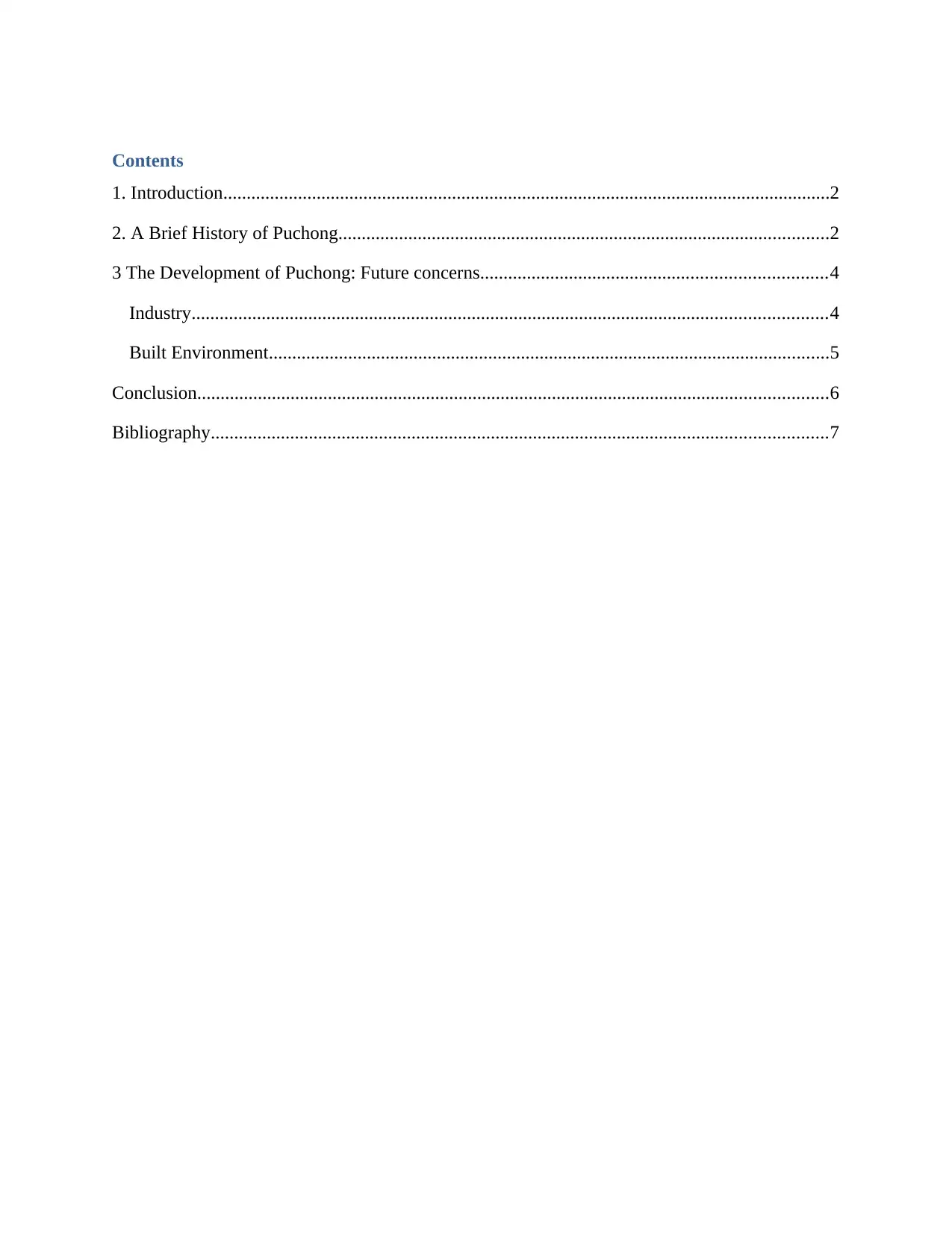
Contents
1. Introduction..................................................................................................................................2
2. A Brief History of Puchong.........................................................................................................2
3 The Development of Puchong: Future concerns..........................................................................4
Industry........................................................................................................................................4
Built Environment........................................................................................................................5
Conclusion.......................................................................................................................................6
Bibliography....................................................................................................................................7
1. Introduction..................................................................................................................................2
2. A Brief History of Puchong.........................................................................................................2
3 The Development of Puchong: Future concerns..........................................................................4
Industry........................................................................................................................................4
Built Environment........................................................................................................................5
Conclusion.......................................................................................................................................6
Bibliography....................................................................................................................................7
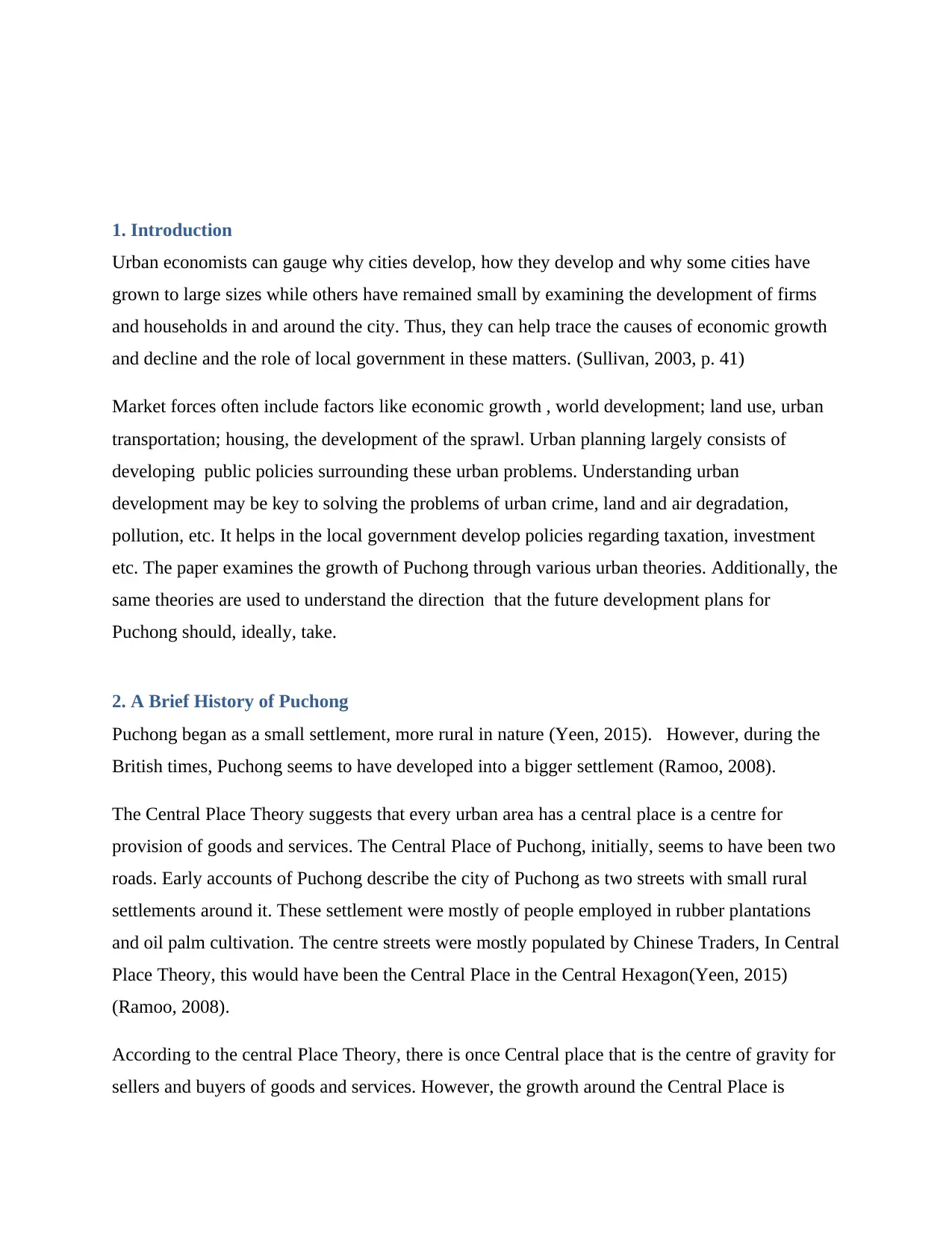
1. Introduction
Urban economists can gauge why cities develop, how they develop and why some cities have
grown to large sizes while others have remained small by examining the development of firms
and households in and around the city. Thus, they can help trace the causes of economic growth
and decline and the role of local government in these matters. (Sullivan, 2003, p. 41)
Market forces often include factors like economic growth , world development; land use, urban
transportation; housing, the development of the sprawl. Urban planning largely consists of
developing public policies surrounding these urban problems. Understanding urban
development may be key to solving the problems of urban crime, land and air degradation,
pollution, etc. It helps in the local government develop policies regarding taxation, investment
etc. The paper examines the growth of Puchong through various urban theories. Additionally, the
same theories are used to understand the direction that the future development plans for
Puchong should, ideally, take.
2. A Brief History of Puchong
Puchong began as a small settlement, more rural in nature (Yeen, 2015). However, during the
British times, Puchong seems to have developed into a bigger settlement (Ramoo, 2008).
The Central Place Theory suggests that every urban area has a central place is a centre for
provision of goods and services. The Central Place of Puchong, initially, seems to have been two
roads. Early accounts of Puchong describe the city of Puchong as two streets with small rural
settlements around it. These settlement were mostly of people employed in rubber plantations
and oil palm cultivation. The centre streets were mostly populated by Chinese Traders, In Central
Place Theory, this would have been the Central Place in the Central Hexagon(Yeen, 2015)
(Ramoo, 2008).
According to the central Place Theory, there is once Central place that is the centre of gravity for
sellers and buyers of goods and services. However, the growth around the Central Place is
Urban economists can gauge why cities develop, how they develop and why some cities have
grown to large sizes while others have remained small by examining the development of firms
and households in and around the city. Thus, they can help trace the causes of economic growth
and decline and the role of local government in these matters. (Sullivan, 2003, p. 41)
Market forces often include factors like economic growth , world development; land use, urban
transportation; housing, the development of the sprawl. Urban planning largely consists of
developing public policies surrounding these urban problems. Understanding urban
development may be key to solving the problems of urban crime, land and air degradation,
pollution, etc. It helps in the local government develop policies regarding taxation, investment
etc. The paper examines the growth of Puchong through various urban theories. Additionally, the
same theories are used to understand the direction that the future development plans for
Puchong should, ideally, take.
2. A Brief History of Puchong
Puchong began as a small settlement, more rural in nature (Yeen, 2015). However, during the
British times, Puchong seems to have developed into a bigger settlement (Ramoo, 2008).
The Central Place Theory suggests that every urban area has a central place is a centre for
provision of goods and services. The Central Place of Puchong, initially, seems to have been two
roads. Early accounts of Puchong describe the city of Puchong as two streets with small rural
settlements around it. These settlement were mostly of people employed in rubber plantations
and oil palm cultivation. The centre streets were mostly populated by Chinese Traders, In Central
Place Theory, this would have been the Central Place in the Central Hexagon(Yeen, 2015)
(Ramoo, 2008).
According to the central Place Theory, there is once Central place that is the centre of gravity for
sellers and buyers of goods and services. However, the growth around the Central Place is
You're viewing a preview
Unlock full access by subscribing today!
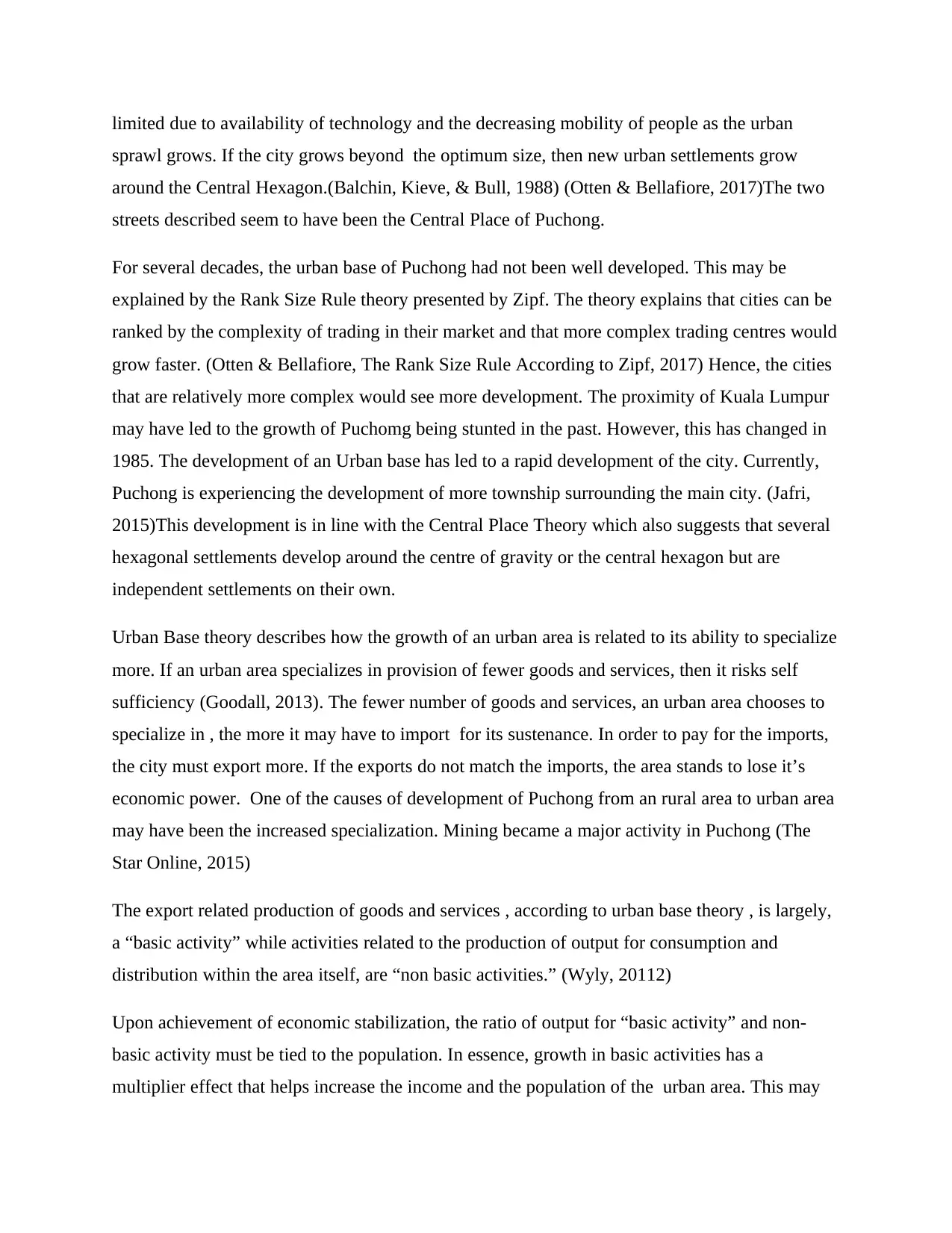
limited due to availability of technology and the decreasing mobility of people as the urban
sprawl grows. If the city grows beyond the optimum size, then new urban settlements grow
around the Central Hexagon.(Balchin, Kieve, & Bull, 1988) (Otten & Bellafiore, 2017)The two
streets described seem to have been the Central Place of Puchong.
For several decades, the urban base of Puchong had not been well developed. This may be
explained by the Rank Size Rule theory presented by Zipf. The theory explains that cities can be
ranked by the complexity of trading in their market and that more complex trading centres would
grow faster. (Otten & Bellafiore, The Rank Size Rule According to Zipf, 2017) Hence, the cities
that are relatively more complex would see more development. The proximity of Kuala Lumpur
may have led to the growth of Puchomg being stunted in the past. However, this has changed in
1985. The development of an Urban base has led to a rapid development of the city. Currently,
Puchong is experiencing the development of more township surrounding the main city. (Jafri,
2015)This development is in line with the Central Place Theory which also suggests that several
hexagonal settlements develop around the centre of gravity or the central hexagon but are
independent settlements on their own.
Urban Base theory describes how the growth of an urban area is related to its ability to specialize
more. If an urban area specializes in provision of fewer goods and services, then it risks self
sufficiency (Goodall, 2013). The fewer number of goods and services, an urban area chooses to
specialize in , the more it may have to import for its sustenance. In order to pay for the imports,
the city must export more. If the exports do not match the imports, the area stands to lose it’s
economic power. One of the causes of development of Puchong from an rural area to urban area
may have been the increased specialization. Mining became a major activity in Puchong (The
Star Online, 2015)
The export related production of goods and services , according to urban base theory , is largely,
a “basic activity” while activities related to the production of output for consumption and
distribution within the area itself, are “non basic activities.” (Wyly, 20112)
Upon achievement of economic stabilization, the ratio of output for “basic activity” and non-
basic activity must be tied to the population. In essence, growth in basic activities has a
multiplier effect that helps increase the income and the population of the urban area. This may
sprawl grows. If the city grows beyond the optimum size, then new urban settlements grow
around the Central Hexagon.(Balchin, Kieve, & Bull, 1988) (Otten & Bellafiore, 2017)The two
streets described seem to have been the Central Place of Puchong.
For several decades, the urban base of Puchong had not been well developed. This may be
explained by the Rank Size Rule theory presented by Zipf. The theory explains that cities can be
ranked by the complexity of trading in their market and that more complex trading centres would
grow faster. (Otten & Bellafiore, The Rank Size Rule According to Zipf, 2017) Hence, the cities
that are relatively more complex would see more development. The proximity of Kuala Lumpur
may have led to the growth of Puchomg being stunted in the past. However, this has changed in
1985. The development of an Urban base has led to a rapid development of the city. Currently,
Puchong is experiencing the development of more township surrounding the main city. (Jafri,
2015)This development is in line with the Central Place Theory which also suggests that several
hexagonal settlements develop around the centre of gravity or the central hexagon but are
independent settlements on their own.
Urban Base theory describes how the growth of an urban area is related to its ability to specialize
more. If an urban area specializes in provision of fewer goods and services, then it risks self
sufficiency (Goodall, 2013). The fewer number of goods and services, an urban area chooses to
specialize in , the more it may have to import for its sustenance. In order to pay for the imports,
the city must export more. If the exports do not match the imports, the area stands to lose it’s
economic power. One of the causes of development of Puchong from an rural area to urban area
may have been the increased specialization. Mining became a major activity in Puchong (The
Star Online, 2015)
The export related production of goods and services , according to urban base theory , is largely,
a “basic activity” while activities related to the production of output for consumption and
distribution within the area itself, are “non basic activities.” (Wyly, 20112)
Upon achievement of economic stabilization, the ratio of output for “basic activity” and non-
basic activity must be tied to the population. In essence, growth in basic activities has a
multiplier effect that helps increase the income and the population of the urban area. This may
Paraphrase This Document
Need a fresh take? Get an instant paraphrase of this document with our AI Paraphraser
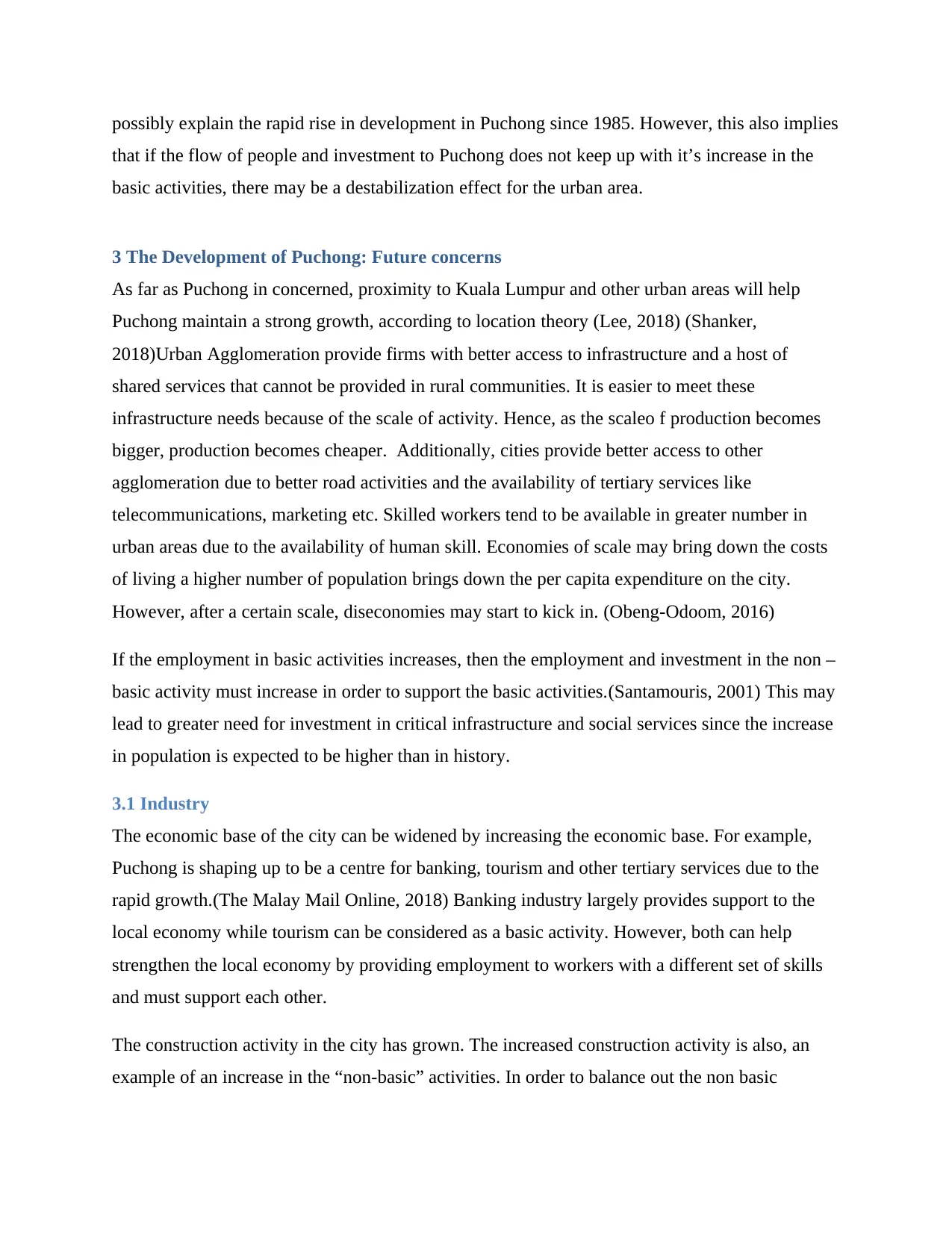
possibly explain the rapid rise in development in Puchong since 1985. However, this also implies
that if the flow of people and investment to Puchong does not keep up with it’s increase in the
basic activities, there may be a destabilization effect for the urban area.
3 The Development of Puchong: Future concerns
As far as Puchong in concerned, proximity to Kuala Lumpur and other urban areas will help
Puchong maintain a strong growth, according to location theory (Lee, 2018) (Shanker,
2018)Urban Agglomeration provide firms with better access to infrastructure and a host of
shared services that cannot be provided in rural communities. It is easier to meet these
infrastructure needs because of the scale of activity. Hence, as the scaleo f production becomes
bigger, production becomes cheaper. Additionally, cities provide better access to other
agglomeration due to better road activities and the availability of tertiary services like
telecommunications, marketing etc. Skilled workers tend to be available in greater number in
urban areas due to the availability of human skill. Economies of scale may bring down the costs
of living a higher number of population brings down the per capita expenditure on the city.
However, after a certain scale, diseconomies may start to kick in. (Obeng-Odoom, 2016)
If the employment in basic activities increases, then the employment and investment in the non –
basic activity must increase in order to support the basic activities.(Santamouris, 2001) This may
lead to greater need for investment in critical infrastructure and social services since the increase
in population is expected to be higher than in history.
3.1 Industry
The economic base of the city can be widened by increasing the economic base. For example,
Puchong is shaping up to be a centre for banking, tourism and other tertiary services due to the
rapid growth.(The Malay Mail Online, 2018) Banking industry largely provides support to the
local economy while tourism can be considered as a basic activity. However, both can help
strengthen the local economy by providing employment to workers with a different set of skills
and must support each other.
The construction activity in the city has grown. The increased construction activity is also, an
example of an increase in the “non-basic” activities. In order to balance out the non basic
that if the flow of people and investment to Puchong does not keep up with it’s increase in the
basic activities, there may be a destabilization effect for the urban area.
3 The Development of Puchong: Future concerns
As far as Puchong in concerned, proximity to Kuala Lumpur and other urban areas will help
Puchong maintain a strong growth, according to location theory (Lee, 2018) (Shanker,
2018)Urban Agglomeration provide firms with better access to infrastructure and a host of
shared services that cannot be provided in rural communities. It is easier to meet these
infrastructure needs because of the scale of activity. Hence, as the scaleo f production becomes
bigger, production becomes cheaper. Additionally, cities provide better access to other
agglomeration due to better road activities and the availability of tertiary services like
telecommunications, marketing etc. Skilled workers tend to be available in greater number in
urban areas due to the availability of human skill. Economies of scale may bring down the costs
of living a higher number of population brings down the per capita expenditure on the city.
However, after a certain scale, diseconomies may start to kick in. (Obeng-Odoom, 2016)
If the employment in basic activities increases, then the employment and investment in the non –
basic activity must increase in order to support the basic activities.(Santamouris, 2001) This may
lead to greater need for investment in critical infrastructure and social services since the increase
in population is expected to be higher than in history.
3.1 Industry
The economic base of the city can be widened by increasing the economic base. For example,
Puchong is shaping up to be a centre for banking, tourism and other tertiary services due to the
rapid growth.(The Malay Mail Online, 2018) Banking industry largely provides support to the
local economy while tourism can be considered as a basic activity. However, both can help
strengthen the local economy by providing employment to workers with a different set of skills
and must support each other.
The construction activity in the city has grown. The increased construction activity is also, an
example of an increase in the “non-basic” activities. In order to balance out the non basic
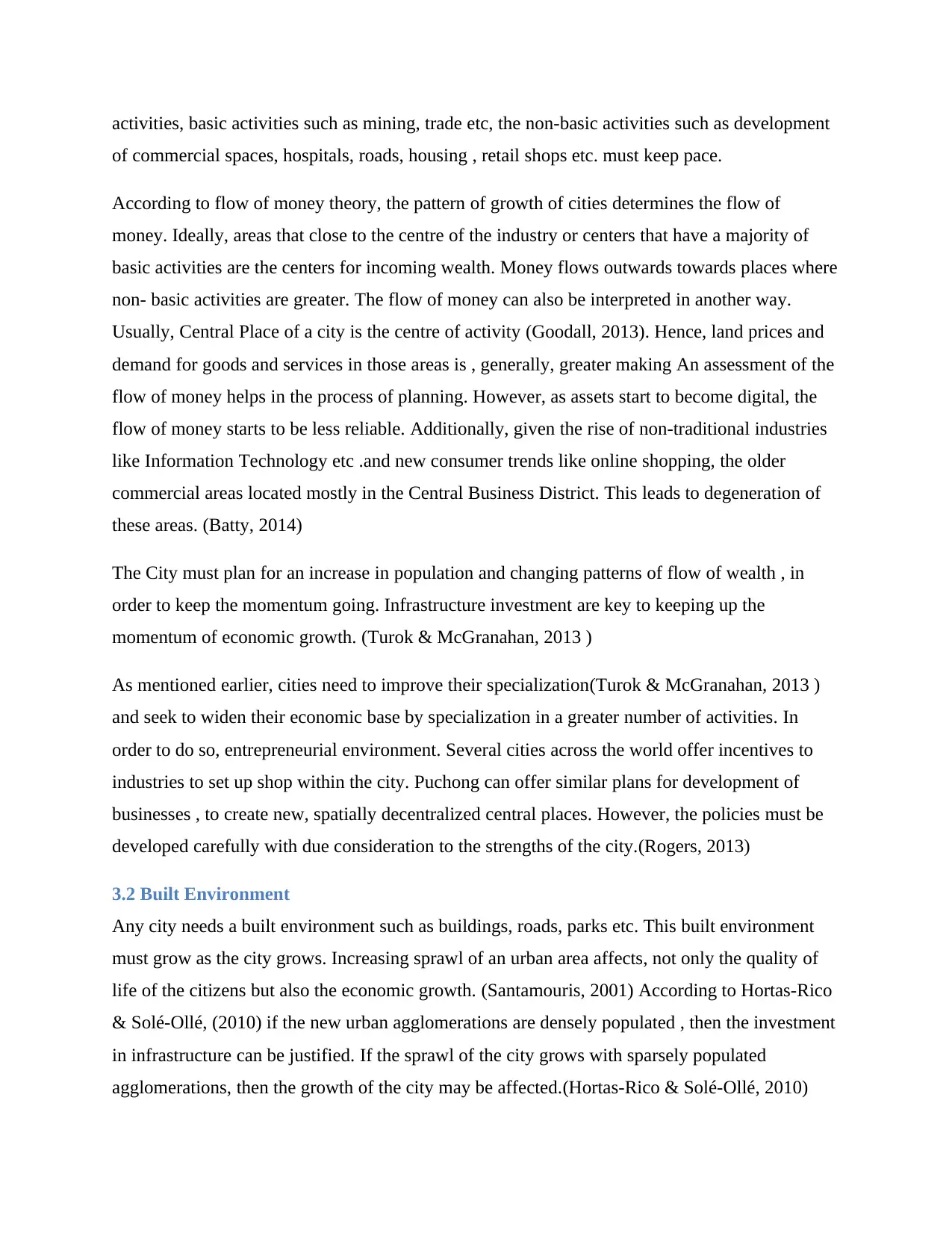
activities, basic activities such as mining, trade etc, the non-basic activities such as development
of commercial spaces, hospitals, roads, housing , retail shops etc. must keep pace.
According to flow of money theory, the pattern of growth of cities determines the flow of
money. Ideally, areas that close to the centre of the industry or centers that have a majority of
basic activities are the centers for incoming wealth. Money flows outwards towards places where
non- basic activities are greater. The flow of money can also be interpreted in another way.
Usually, Central Place of a city is the centre of activity (Goodall, 2013). Hence, land prices and
demand for goods and services in those areas is , generally, greater making An assessment of the
flow of money helps in the process of planning. However, as assets start to become digital, the
flow of money starts to be less reliable. Additionally, given the rise of non-traditional industries
like Information Technology etc .and new consumer trends like online shopping, the older
commercial areas located mostly in the Central Business District. This leads to degeneration of
these areas. (Batty, 2014)
The City must plan for an increase in population and changing patterns of flow of wealth , in
order to keep the momentum going. Infrastructure investment are key to keeping up the
momentum of economic growth. (Turok & McGranahan, 2013 )
As mentioned earlier, cities need to improve their specialization(Turok & McGranahan, 2013 )
and seek to widen their economic base by specialization in a greater number of activities. In
order to do so, entrepreneurial environment. Several cities across the world offer incentives to
industries to set up shop within the city. Puchong can offer similar plans for development of
businesses , to create new, spatially decentralized central places. However, the policies must be
developed carefully with due consideration to the strengths of the city.(Rogers, 2013)
3.2 Built Environment
Any city needs a built environment such as buildings, roads, parks etc. This built environment
must grow as the city grows. Increasing sprawl of an urban area affects, not only the quality of
life of the citizens but also the economic growth. (Santamouris, 2001) According to Hortas-Rico
& Solé-Ollé, (2010) if the new urban agglomerations are densely populated , then the investment
in infrastructure can be justified. If the sprawl of the city grows with sparsely populated
agglomerations, then the growth of the city may be affected.(Hortas-Rico & Solé-Ollé, 2010)
of commercial spaces, hospitals, roads, housing , retail shops etc. must keep pace.
According to flow of money theory, the pattern of growth of cities determines the flow of
money. Ideally, areas that close to the centre of the industry or centers that have a majority of
basic activities are the centers for incoming wealth. Money flows outwards towards places where
non- basic activities are greater. The flow of money can also be interpreted in another way.
Usually, Central Place of a city is the centre of activity (Goodall, 2013). Hence, land prices and
demand for goods and services in those areas is , generally, greater making An assessment of the
flow of money helps in the process of planning. However, as assets start to become digital, the
flow of money starts to be less reliable. Additionally, given the rise of non-traditional industries
like Information Technology etc .and new consumer trends like online shopping, the older
commercial areas located mostly in the Central Business District. This leads to degeneration of
these areas. (Batty, 2014)
The City must plan for an increase in population and changing patterns of flow of wealth , in
order to keep the momentum going. Infrastructure investment are key to keeping up the
momentum of economic growth. (Turok & McGranahan, 2013 )
As mentioned earlier, cities need to improve their specialization(Turok & McGranahan, 2013 )
and seek to widen their economic base by specialization in a greater number of activities. In
order to do so, entrepreneurial environment. Several cities across the world offer incentives to
industries to set up shop within the city. Puchong can offer similar plans for development of
businesses , to create new, spatially decentralized central places. However, the policies must be
developed carefully with due consideration to the strengths of the city.(Rogers, 2013)
3.2 Built Environment
Any city needs a built environment such as buildings, roads, parks etc. This built environment
must grow as the city grows. Increasing sprawl of an urban area affects, not only the quality of
life of the citizens but also the economic growth. (Santamouris, 2001) According to Hortas-Rico
& Solé-Ollé, (2010) if the new urban agglomerations are densely populated , then the investment
in infrastructure can be justified. If the sprawl of the city grows with sparsely populated
agglomerations, then the growth of the city may be affected.(Hortas-Rico & Solé-Ollé, 2010)
You're viewing a preview
Unlock full access by subscribing today!
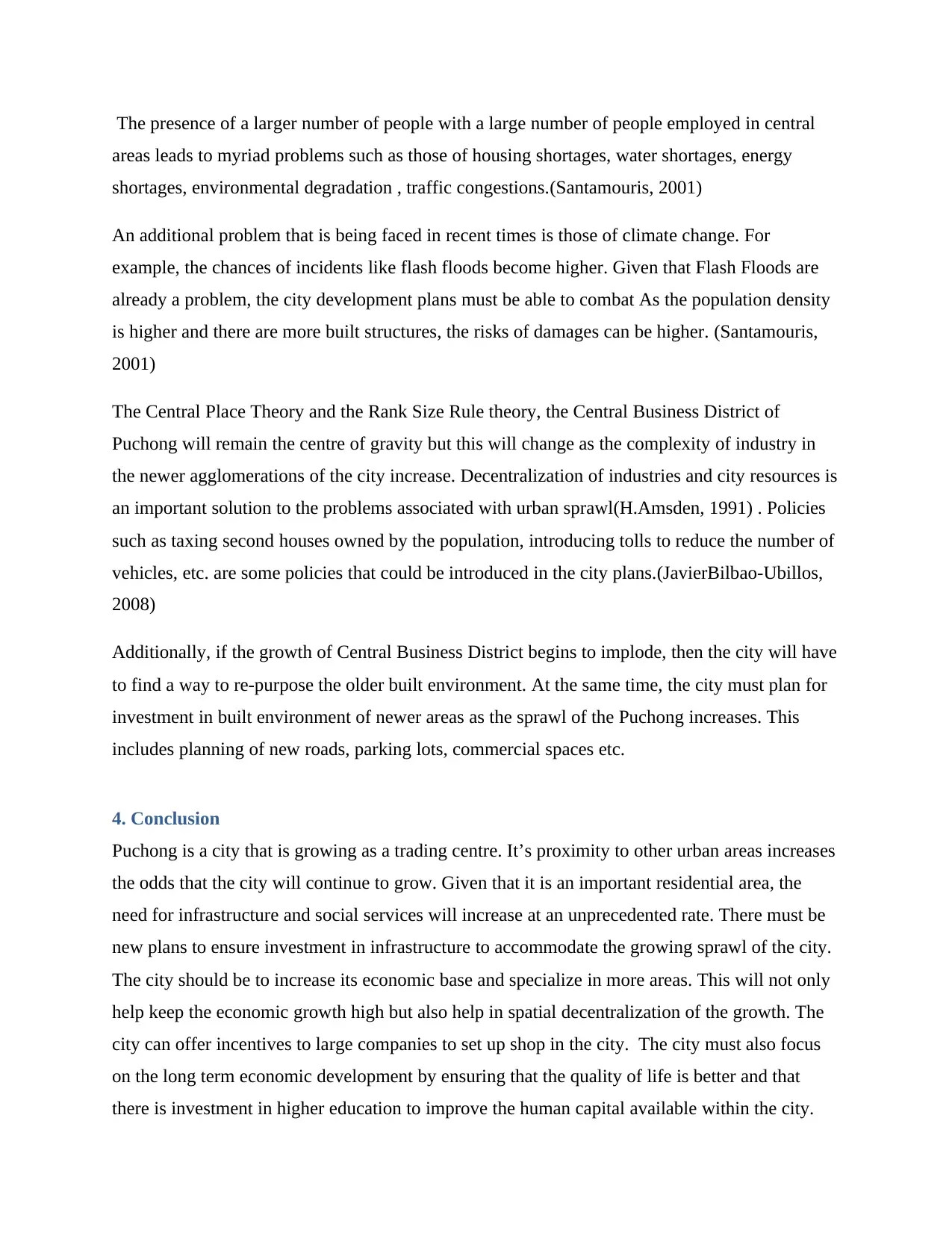
The presence of a larger number of people with a large number of people employed in central
areas leads to myriad problems such as those of housing shortages, water shortages, energy
shortages, environmental degradation , traffic congestions.(Santamouris, 2001)
An additional problem that is being faced in recent times is those of climate change. For
example, the chances of incidents like flash floods become higher. Given that Flash Floods are
already a problem, the city development plans must be able to combat As the population density
is higher and there are more built structures, the risks of damages can be higher. (Santamouris,
2001)
The Central Place Theory and the Rank Size Rule theory, the Central Business District of
Puchong will remain the centre of gravity but this will change as the complexity of industry in
the newer agglomerations of the city increase. Decentralization of industries and city resources is
an important solution to the problems associated with urban sprawl(H.Amsden, 1991) . Policies
such as taxing second houses owned by the population, introducing tolls to reduce the number of
vehicles, etc. are some policies that could be introduced in the city plans.(JavierBilbao-Ubillos,
2008)
Additionally, if the growth of Central Business District begins to implode, then the city will have
to find a way to re-purpose the older built environment. At the same time, the city must plan for
investment in built environment of newer areas as the sprawl of the Puchong increases. This
includes planning of new roads, parking lots, commercial spaces etc.
4. Conclusion
Puchong is a city that is growing as a trading centre. It’s proximity to other urban areas increases
the odds that the city will continue to grow. Given that it is an important residential area, the
need for infrastructure and social services will increase at an unprecedented rate. There must be
new plans to ensure investment in infrastructure to accommodate the growing sprawl of the city.
The city should be to increase its economic base and specialize in more areas. This will not only
help keep the economic growth high but also help in spatial decentralization of the growth. The
city can offer incentives to large companies to set up shop in the city. The city must also focus
on the long term economic development by ensuring that the quality of life is better and that
there is investment in higher education to improve the human capital available within the city.
areas leads to myriad problems such as those of housing shortages, water shortages, energy
shortages, environmental degradation , traffic congestions.(Santamouris, 2001)
An additional problem that is being faced in recent times is those of climate change. For
example, the chances of incidents like flash floods become higher. Given that Flash Floods are
already a problem, the city development plans must be able to combat As the population density
is higher and there are more built structures, the risks of damages can be higher. (Santamouris,
2001)
The Central Place Theory and the Rank Size Rule theory, the Central Business District of
Puchong will remain the centre of gravity but this will change as the complexity of industry in
the newer agglomerations of the city increase. Decentralization of industries and city resources is
an important solution to the problems associated with urban sprawl(H.Amsden, 1991) . Policies
such as taxing second houses owned by the population, introducing tolls to reduce the number of
vehicles, etc. are some policies that could be introduced in the city plans.(JavierBilbao-Ubillos,
2008)
Additionally, if the growth of Central Business District begins to implode, then the city will have
to find a way to re-purpose the older built environment. At the same time, the city must plan for
investment in built environment of newer areas as the sprawl of the Puchong increases. This
includes planning of new roads, parking lots, commercial spaces etc.
4. Conclusion
Puchong is a city that is growing as a trading centre. It’s proximity to other urban areas increases
the odds that the city will continue to grow. Given that it is an important residential area, the
need for infrastructure and social services will increase at an unprecedented rate. There must be
new plans to ensure investment in infrastructure to accommodate the growing sprawl of the city.
The city should be to increase its economic base and specialize in more areas. This will not only
help keep the economic growth high but also help in spatial decentralization of the growth. The
city can offer incentives to large companies to set up shop in the city. The city must also focus
on the long term economic development by ensuring that the quality of life is better and that
there is investment in higher education to improve the human capital available within the city.
Paraphrase This Document
Need a fresh take? Get an instant paraphrase of this document with our AI Paraphraser
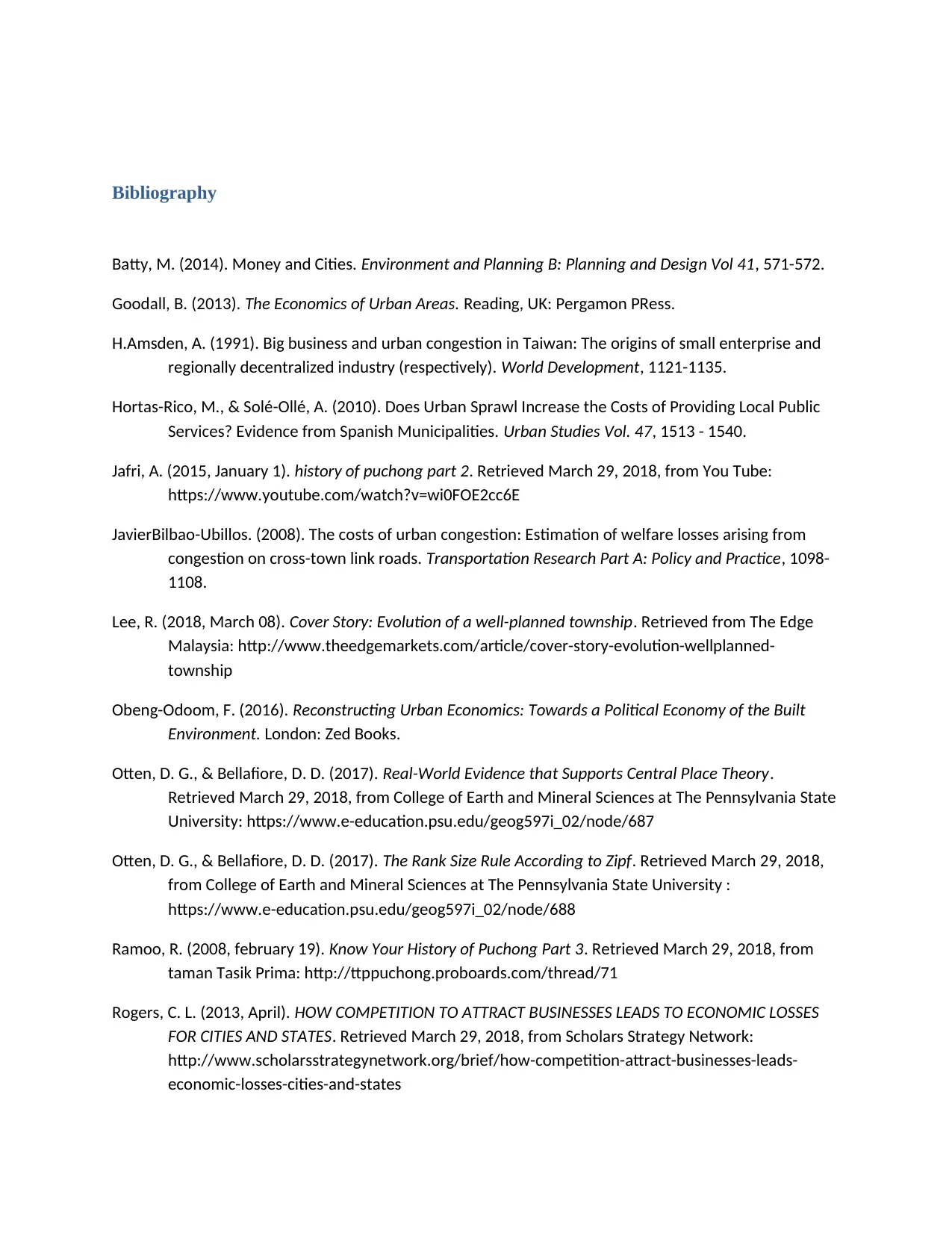
Bibliography
Batty, M. (2014). Money and Cities. Environment and Planning B: Planning and Design Vol 41, 571-572.
Goodall, B. (2013). The Economics of Urban Areas. Reading, UK: Pergamon PRess.
H.Amsden, A. (1991). Big business and urban congestion in Taiwan: The origins of small enterprise and
regionally decentralized industry (respectively). World Development, 1121-1135.
Hortas-Rico, M., & Solé-Ollé, A. (2010). Does Urban Sprawl Increase the Costs of Providing Local Public
Services? Evidence from Spanish Municipalities. Urban Studies Vol. 47, 1513 - 1540.
Jafri, A. (2015, January 1). history of puchong part 2. Retrieved March 29, 2018, from You Tube:
https://www.youtube.com/watch?v=wi0FOE2cc6E
JavierBilbao-Ubillos. (2008). The costs of urban congestion: Estimation of welfare losses arising from
congestion on cross-town link roads. Transportation Research Part A: Policy and Practice, 1098-
1108.
Lee, R. (2018, March 08). Cover Story: Evolution of a well-planned township. Retrieved from The Edge
Malaysia: http://www.theedgemarkets.com/article/cover-story-evolution-wellplanned-
township
Obeng-Odoom, F. (2016). Reconstructing Urban Economics: Towards a Political Economy of the Built
Environment. London: Zed Books.
Otten, D. G., & Bellafiore, D. D. (2017). Real-World Evidence that Supports Central Place Theory.
Retrieved March 29, 2018, from College of Earth and Mineral Sciences at The Pennsylvania State
University: https://www.e-education.psu.edu/geog597i_02/node/687
Otten, D. G., & Bellafiore, D. D. (2017). The Rank Size Rule According to Zipf. Retrieved March 29, 2018,
from College of Earth and Mineral Sciences at The Pennsylvania State University :
https://www.e-education.psu.edu/geog597i_02/node/688
Ramoo, R. (2008, february 19). Know Your History of Puchong Part 3. Retrieved March 29, 2018, from
taman Tasik Prima: http://ttppuchong.proboards.com/thread/71
Rogers, C. L. (2013, April). HOW COMPETITION TO ATTRACT BUSINESSES LEADS TO ECONOMIC LOSSES
FOR CITIES AND STATES. Retrieved March 29, 2018, from Scholars Strategy Network:
http://www.scholarsstrategynetwork.org/brief/how-competition-attract-businesses-leads-
economic-losses-cities-and-states
Batty, M. (2014). Money and Cities. Environment and Planning B: Planning and Design Vol 41, 571-572.
Goodall, B. (2013). The Economics of Urban Areas. Reading, UK: Pergamon PRess.
H.Amsden, A. (1991). Big business and urban congestion in Taiwan: The origins of small enterprise and
regionally decentralized industry (respectively). World Development, 1121-1135.
Hortas-Rico, M., & Solé-Ollé, A. (2010). Does Urban Sprawl Increase the Costs of Providing Local Public
Services? Evidence from Spanish Municipalities. Urban Studies Vol. 47, 1513 - 1540.
Jafri, A. (2015, January 1). history of puchong part 2. Retrieved March 29, 2018, from You Tube:
https://www.youtube.com/watch?v=wi0FOE2cc6E
JavierBilbao-Ubillos. (2008). The costs of urban congestion: Estimation of welfare losses arising from
congestion on cross-town link roads. Transportation Research Part A: Policy and Practice, 1098-
1108.
Lee, R. (2018, March 08). Cover Story: Evolution of a well-planned township. Retrieved from The Edge
Malaysia: http://www.theedgemarkets.com/article/cover-story-evolution-wellplanned-
township
Obeng-Odoom, F. (2016). Reconstructing Urban Economics: Towards a Political Economy of the Built
Environment. London: Zed Books.
Otten, D. G., & Bellafiore, D. D. (2017). Real-World Evidence that Supports Central Place Theory.
Retrieved March 29, 2018, from College of Earth and Mineral Sciences at The Pennsylvania State
University: https://www.e-education.psu.edu/geog597i_02/node/687
Otten, D. G., & Bellafiore, D. D. (2017). The Rank Size Rule According to Zipf. Retrieved March 29, 2018,
from College of Earth and Mineral Sciences at The Pennsylvania State University :
https://www.e-education.psu.edu/geog597i_02/node/688
Ramoo, R. (2008, february 19). Know Your History of Puchong Part 3. Retrieved March 29, 2018, from
taman Tasik Prima: http://ttppuchong.proboards.com/thread/71
Rogers, C. L. (2013, April). HOW COMPETITION TO ATTRACT BUSINESSES LEADS TO ECONOMIC LOSSES
FOR CITIES AND STATES. Retrieved March 29, 2018, from Scholars Strategy Network:
http://www.scholarsstrategynetwork.org/brief/how-competition-attract-businesses-leads-
economic-losses-cities-and-states
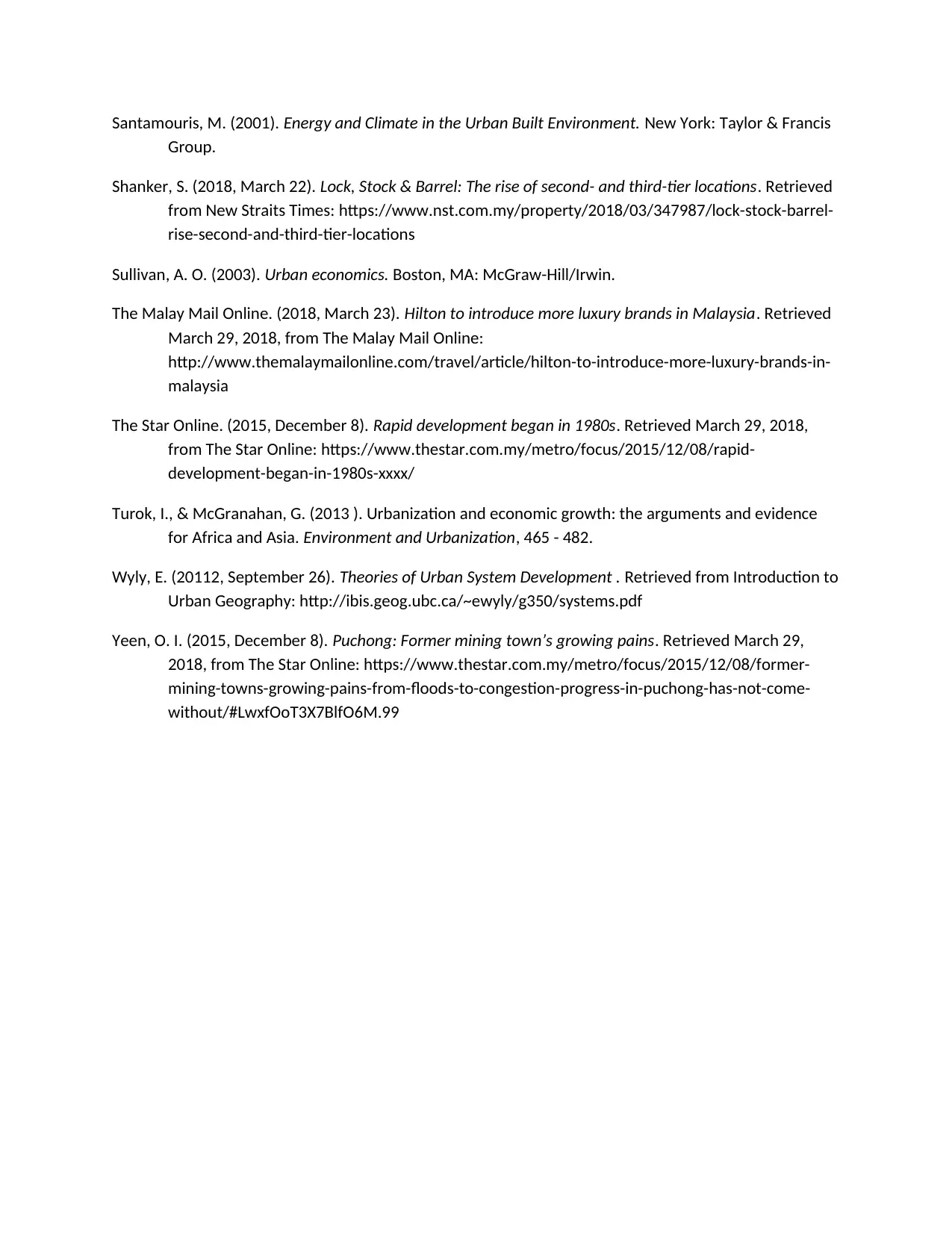
Santamouris, M. (2001). Energy and Climate in the Urban Built Environment. New York: Taylor & Francis
Group.
Shanker, S. (2018, March 22). Lock, Stock & Barrel: The rise of second- and third-tier locations. Retrieved
from New Straits Times: https://www.nst.com.my/property/2018/03/347987/lock-stock-barrel-
rise-second-and-third-tier-locations
Sullivan, A. O. (2003). Urban economics. Boston, MA: McGraw-Hill/Irwin.
The Malay Mail Online. (2018, March 23). Hilton to introduce more luxury brands in Malaysia. Retrieved
March 29, 2018, from The Malay Mail Online:
http://www.themalaymailonline.com/travel/article/hilton-to-introduce-more-luxury-brands-in-
malaysia
The Star Online. (2015, December 8). Rapid development began in 1980s. Retrieved March 29, 2018,
from The Star Online: https://www.thestar.com.my/metro/focus/2015/12/08/rapid-
development-began-in-1980s-xxxx/
Turok, I., & McGranahan, G. (2013 ). Urbanization and economic growth: the arguments and evidence
for Africa and Asia. Environment and Urbanization, 465 - 482.
Wyly, E. (20112, September 26). Theories of Urban System Development . Retrieved from Introduction to
Urban Geography: http://ibis.geog.ubc.ca/~ewyly/g350/systems.pdf
Yeen, O. I. (2015, December 8). Puchong: Former mining town’s growing pains. Retrieved March 29,
2018, from The Star Online: https://www.thestar.com.my/metro/focus/2015/12/08/former-
mining-towns-growing-pains-from-floods-to-congestion-progress-in-puchong-has-not-come-
without/#LwxfOoT3X7BlfO6M.99
Group.
Shanker, S. (2018, March 22). Lock, Stock & Barrel: The rise of second- and third-tier locations. Retrieved
from New Straits Times: https://www.nst.com.my/property/2018/03/347987/lock-stock-barrel-
rise-second-and-third-tier-locations
Sullivan, A. O. (2003). Urban economics. Boston, MA: McGraw-Hill/Irwin.
The Malay Mail Online. (2018, March 23). Hilton to introduce more luxury brands in Malaysia. Retrieved
March 29, 2018, from The Malay Mail Online:
http://www.themalaymailonline.com/travel/article/hilton-to-introduce-more-luxury-brands-in-
malaysia
The Star Online. (2015, December 8). Rapid development began in 1980s. Retrieved March 29, 2018,
from The Star Online: https://www.thestar.com.my/metro/focus/2015/12/08/rapid-
development-began-in-1980s-xxxx/
Turok, I., & McGranahan, G. (2013 ). Urbanization and economic growth: the arguments and evidence
for Africa and Asia. Environment and Urbanization, 465 - 482.
Wyly, E. (20112, September 26). Theories of Urban System Development . Retrieved from Introduction to
Urban Geography: http://ibis.geog.ubc.ca/~ewyly/g350/systems.pdf
Yeen, O. I. (2015, December 8). Puchong: Former mining town’s growing pains. Retrieved March 29,
2018, from The Star Online: https://www.thestar.com.my/metro/focus/2015/12/08/former-
mining-towns-growing-pains-from-floods-to-congestion-progress-in-puchong-has-not-come-
without/#LwxfOoT3X7BlfO6M.99
You're viewing a preview
Unlock full access by subscribing today!
1 out of 9
Your All-in-One AI-Powered Toolkit for Academic Success.
+13062052269
info@desklib.com
Available 24*7 on WhatsApp / Email
![[object Object]](/_next/static/media/star-bottom.7253800d.svg)
Unlock your academic potential
© 2024 | Zucol Services PVT LTD | All rights reserved.


